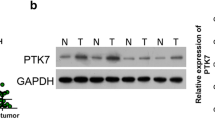Abstract
Cancer stem cells (CSCs) are a distinct population in tumors and cause cancer relapse and metastasis. Thus, treating CSCs are believed to be potential to cure rapidly growing and highly metastatic cancers. To date, CSCs in esophageal cancer have not been characterized. In the current study, we detected significant higher levels of placental growth factor (PLGF) and matrix metalloproteinase 9 (MMP9) in the esophageal cancers with metastasis, compared to those without metastasis, in which the expression levels of PLGF and MMP9 strongly correlated with each other. Thus, we used a human esophageal cancer cell line, TE-1, to examine the cross talk of PLGF and MMP9. We found that the levels of PLGF in TE-1 cells positively affected the levels of MMP9, while the levels of MMP9 did not affected the levels of PLGF, suggesting that PLGF may activate MMP9 in esophageal cancer cells. Then, we separated PLGF-positive and PLGF-negative TE-1 cells that had been transfected with a GFP reporter under a PLGF promoter by flow cytometry. We found that PLGF-positive cells grew significantly faster than PLGF-negative cells both in vitro and in vivo in a stereotactical implantation model, suggesting that PLGF-positive cells are likely CSCs in esophageal cancer. Taken together, we demonstrate that PLGF-positive cells appear to be CSCs in esophageal cancer, and they may release PLGF to promote cancer metastasis through MMP9 activation.





Similar content being viewed by others
References
Umar SB, Fleischer DE. Esophageal cancer: epidemiology, pathogenesis and prevention. Nat Clin Pract Gastroenterol Hepatol. 2008;5:517–26. doi:10.1038/ncpgasthep1223.
Holmes RS, Vaughan TL. Epidemiology and pathogenesis of esophageal cancer. Semin Radiat Oncol. 2007;17:2–9.
Petersson M, Niemann C. Stem cell dynamics and heterogeneity: implications for epidermal regeneration and skin cancer. Curr Med Chem. 2012;19:5984–92.
Perez-Losada J, Balmain A. Stem-cell hierarchy in skin cancer. Nat Rev Cancer. 2003;3:434–43.
Dufour A, Overall CM. Missing the target: matrix metalloproteinase antitargets in inflammation and cancer. Trends Pharmacol Sci. 2013;34:233–42.
Ferrara N. Vascular endothelial growth factor. Arterioscler Thromb Vasc Biol. 2009;29:789–91.
Xiao X, Prasadan K, Guo P, El-Gohary Y, Fischbach S, Wiersch J, et al. Pancreatic duct cells as a source of VEGF in mice. Diabetologia. 2014;57:991–1000.
Xiao X, Guo P, Chen Z, El-Gohary Y, Wiersch J, Gaffar I, et al. Hypoglycemia reduces vascular endothelial growth factor a production by pancreatic beta cells as a regulator of beta cell mass. J Biol Chem. 2013;288:8636–46.
Carmeliet P, Moons L, Luttun A, Vincenti V, Compernolle V, De Mol M, et al. Synergism between vascular endothelial growth factor and placental growth factor contributes to angiogenesis and plasma extravasation in pathological conditions. Nat Med. 2001;7:575–83.
Eriksson A, Cao R, Pawliuk R, Berg SM, Tsang M, Zhou D, et al. Placenta growth factor-1 antagonizes VEGF-induced angiogenesis and tumor growth by the formation of functionally inactive PlGF-1/VEGF heterodimers. Cancer Cell. 2002;1:99–108.
Davidson B, Reich R, Risberg B, Nesland JM. The biological role and regulation of matrix metalloproteinases (MMP) in cancer. Arkh Patol. 2002;64:47–53.
Rhee JS, Coussens LM. RECKing MMP function: implications for cancer development. Trends Cell Biol. 2002;12:209–11.
Li B, Tsao SW, Li YY, Wang X, Ling MT, Wong YC, et al. Id-1 promotes tumorigenicity and metastasis of human esophageal cancer cells through activation of PI3K/AKT signaling pathway. Int J Cancer. 2009;125:2576–85.
Mroczko B, Kozlowski M, Groblewska M, Lukaszewicz M, Niklinski J, Laudanski J, et al. Expression of matrix metalloproteinase-9 in the neoplastic and interstitial inflammatory infiltrate cells in the different histopathological types of esophageal cancer. Folia Histochem Cytobiol. 2008;46:471–8.
Kataoka M, Yamagata S, Takagi H, Thant A, Akiyama S, Iida K, et al. Matrix metalloproteinase 2 and 9 in esophageal cancer. Int J Oncol. 1996;8:773–9.
Shima I, Sasaguri Y, Arima N, Yamana H, Fujita H, Morimatsu M, et al. Expression of epidermal growth-factor (EGF), matrix metalloproteinase-9 (mmp-9) and proliferating cell nuclear antigen (pcna) in esophageal cancer. Int J Oncol. 1995;6:833–9.
Hori T, Yamashita Y, Ohira M, Matsumura Y, Muguruma K, Hirakawa K. A novel orthotopic implantation model of human esophageal carcinoma in nude rats: CD44H mediates cancer cell invasion in vitro and in vivo. Int J Cancer. 2001;92:489–96.
Zhou X, Qi Y. PlGF inhibition impairs metastasis of larynx carcinoma through MMP3 downregulation. Tumour Biol. 2014. doi:https://doi.org/10.1007/s13277-014-2232-2.
Zins K, Thomas A, Lucas T, Sioud M, Aharinejad S, Abraham D. Inhibition of stromal PlGF suppresses the growth of prostate cancer xenografts. Int J Mol Sci. 2013;14:17958–71.
Li B, Wang C, Zhang Y, Zhao XY, Huang B, Wu PF, et al. Elevated PLGF contributes to small-cell lung cancer brain metastasis. Oncogene. 2013;32:2952–62.
Laurent J, Hull EF, Touvrey C, Kuonen F, Lan Q, Lorusso G, et al. Proangiogenic factor PlGF programs CD11b(+) myelomonocytes in breast cancer during differentiation of their hematopoietic progenitors. Cancer Res. 2011;71:3781–91.
Van de Veire S, Stalmans I, Heindryckx F, Oura H, Tijeras-Raballand A, Schmidt T, et al. Further pharmacological and genetic evidence for the efficacy of PlGF inhibition in cancer and eye disease. Cell. 2010;141:178–90.
Crawford HC, Fingleton BM, Rudolph-Owen LA, Goss KJ, Rubinfeld B, Polakis P, et al. The metalloproteinase matrilysin is a target of beta-catenin transactivation in intestinal tumors. Oncogene. 1999;18:2883–91.
Holland JD, Klaus A, Garratt AN, Birchmeier W. Wnt signaling in stem and cancer stem cells. Curr Opin Cell Biol. 2013;25:254–64.
Acknowledgments
This work was financially supported by the Shanghai Municipal Commission of Health and Family Planning Foundation No. 20134036.
Conflicts of interest
None
Author information
Authors and Affiliations
Corresponding author
Rights and permissions
About this article
Cite this article
Chen, Y., Jiang, T., Mao, A. et al. Esophageal cancer stem cells express PLGF to increase cancer invasion through MMP9 activation. Tumor Biol. 35, 12749–12755 (2014). https://doi.org/10.1007/s13277-014-2601-x
Received:
Accepted:
Published:
Issue Date:
DOI: https://doi.org/10.1007/s13277-014-2601-x




